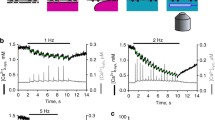Abstract
LOW concentrations of inositol 1,4,5-trisphosphate (InsP3) evoke a very rapid mobilization of intracellular Ca2+ stores in many cell types, which can be followed by a further, much slower efflux1–8. Two explanations have been suggested for this biphasic release. The first proposes that the Ca2+ stores vary in their sensitivity to InsP3, and each store releases either its entire contents or nothing2,5,7 (all-or-none release); the second proposes instead that the stores are uniformly sensitive to the effects of InsP3, but that they can release only a fraction of their Ca2+ before their sensitivity is somehow attenuated6,8–11(steady-state release). Experiments using purified InsP3 receptor molecules reconstituted into lipid vesicles have shown heterogeneity of the receptors in their response to InsP3 under conditions in which the total Ca2+ level at both sides of the receptor is held constant7. We now report that in permeabilized A7r5 smooth-muscle cells incubated in Ca2+-free medium, the amount of 45Ca2+ remaining in the stores after the rapid transient phase of release is independent of their initial Ca2+ levels, indicating that partially depleted stores are less sensitive to InsP3. Moreover, if the stores are reloaded with 40Ca2+ after the first stimulus, reapplication of the same low concentration of InsP3 will release further 45Ca2+. This recovery of InsP3 sensitivity is almost complete. Under these conditions, Ca2+ release must thus occur by a steady-state mechanism, in which the decreasing Ca2+ content of the stores slows down further release.
Similar content being viewed by others
References
Berridge, M. J. & Irvine, R. F. Nature 341, 197–205 (1989).
Muallem, S., Pandol, S. J. & Beeker, T. G. J. biol. Chem. 264, 205–212 (1989).
Meyer, T. & Stryer, L. Proc. natn. Acad. Sci. U.S.A. 87, 3841–3845 (1990).
Taylor, C. W. & Potter, B. V. L. Biochem. J. 266, 189–194 (1990).
Oldershaw, K. A., Nunn, D. L. & Taylor, C. W. Biochem. J. 278, 705–708 (1991).
Finch, E. A., Turner, T. J. & Goldin, S. M. Science 252, 443–446 (1991).
Ferris, C. D., Cameron, A. M., Huganir, R. L. & Snyder, S. H. Nature 356, 350–352 (1992).
Champeil, P. et al. J. biol. Cbem. 264, 17665–17673 (1989).
Irvine, R. F. FEBS Lett. 263, 5–9 (1990).
Tregear, R., Dawson, A. P. & Irvine, R. F. Proc. R. Soc. B243, 263–268 (1991).
Irvine, R. F. Bioessays 13, 419–427 (1991).
Morris, A. J. Murray, K. J., England, P. J., Downes, C. P. & Michell, R. H. Biochem. J. 251, 157–163 (1988).
Hill, T. D., Dean, N. M. & Boynton, A. L. Science 242, 1176–1178 (1988).
Bird, G. St J. et al. Nature 352, 162–165 (1991).
Menniti, F. S. et al. J. biol. Chem. 266, 13646–13653 (1991).
Satoh, T. et al. J. Cell Biol. 111, 615–624 (1990).
Ghosh, T. K., Mullaney, J. M., Tarazi, F. I. & Gill, D. L. Nature 340, 236–239 (1989).
Bezprozvanny, I., Watras, J. & Ehrlich, B. E. Nature 351, 751–754 (1991).
Maeda, N. et al. J. biol. Chem. 266, 1109–1116 (1991).
Iino, M. J. gen. Physiol. 95, 1103–1122 (1990).
Parker, I. & Yao, Y. Proc. R. Soc. B246, 269–274 (1991).
Peres, A. FEBS Lett. 275, 213–216 (1990).
Danoff, S. K. et al. Proc. natn. Acad. Sci. U.S.A. 88, 2951–2955 (1991).
Nakagawa, T., Okano, H., Furuichi, T., Aruga, J. & Mikoshiba, K. Proc. natn. Acad. Sci. U.S.A. 88, 6244–6248 (1991).
Südhof, T. C., Newton, C. L., Archer, B. T. III. Ushkaryov, Y. A. & Mignery, G. A. EMBO J. 10, 3199–3206 (1991).
Nunn, D. L. & Taylor, C. W. Molec. Pharmac. 41, 115–119 (1992).
Parker, I. & Ivorra, I. Science 250, 977–979 (1990).
Meyer, T., Wensel, T. & Stryer, L. Biochemistry 29, 32–37 (1990).
Stern, M. D. Cell Calcium 13, 183–192 (1992).
Missiaen, L., Taylor, C. W. & Berridge, M. J. Nature 352, 241–244 (1991).
Lechleiter, J., Girard, S., Peralta, E. & Clapham, D. Science 252, 123–126 (1991).
Missiaen, L. et al. J. Physiol., Lond. 427, 171–186 (1990).
Author information
Authors and Affiliations
Rights and permissions
About this article
Cite this article
Missiaen, L., De Smedt, H., Droogmans, G. et al. Ca2+ release induced by inositol 1,4,5-trisphosphate is a steady-state phenomenon controlled by luminal Ca2+ in permeabilized cells. Nature 357, 599–602 (1992). https://doi.org/10.1038/357599a0
Received:
Accepted:
Issue Date:
DOI: https://doi.org/10.1038/357599a0
- Springer Nature Limited
This article is cited by
-
Gene expressions in cerebral palsy subjects reveal structural and functional changes in the gastrocnemius muscle that are closely associated with passive muscle stiffness
Cell and Tissue Research (2021)
-
Role of defective Ca2+ signaling in skeletal muscle weakness: Pharmacological implications
Journal of Cell Communication and Signaling (2018)
-
Regulatory Mechanisms of Endoplasmic Reticulum Resident IP3 Receptors
Journal of Molecular Neuroscience (2015)
-
Increased expression of calcium-sensing receptors in atherosclerosis confers hypersensitivity to acute myocardial infarction in rats
Molecular and Cellular Biochemistry (2012)
-
PMR1/SPCA Ca2+ pumps and the role of the Golgi apparatus as a Ca2+ store
Pflügers Archiv - European Journal of Physiology (2003)





